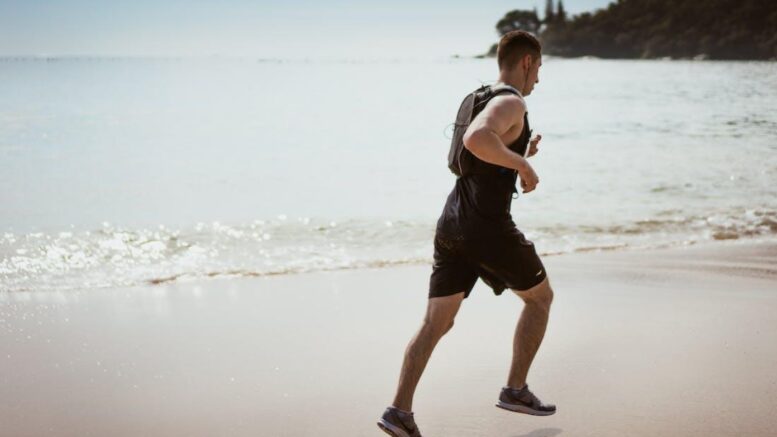Are you looking for tips and strategies on running on a beach? It can be both incredibly invigorating yet more challenging compared to other terrain.
We’ve asked the pacepassion.com experts to provide pro-tips for an effective workout when running on the beach so you can get the most out of your exercise routine! Join us as we dive into how you can conquer any sandy shoreline like a pro.
5 Benefits of Running on the Beach
Running on the beach have several benefits for your body:
1. Increased Energy Expenditure
One of the major benefits of running on the beach is that it requires 1.6 times more energy expenditure compared to running on a firmer surface. It is a great option for those looking to up their calorie burn or increase endurance.
2. Softer Landing
Running on the beach can provide a softer landing experience than running on other surfaces. As you run, the sand beneath your feet naturally cushions each stride. This helps to absorb impact and reduce the risk of stress-related injuries from hard pavement or rocky terrain.
3. Strengthening of Smaller Muscles
The uneven terrain and soft surface of sand requires the muscles in your lower body — such as your glutes, quads, hamstrings and calves — to work harder than they would on a flat surface like pavement or a running track.
4. Improved Athletic Performance
The soft surface created by shifting sand makes running on the beach less stressful on the joints compared to running on a solid outdoor or indoor surface, allowing athletes to push themselves harder while still minimizing joint impact.
5. Core Challenge
The uneven surface of the sand requires additional stabilization from the core, leading to improved balance and overall strength. This stability enhancement can help you become a better athlete as well as reducing muscle stress in other areas of your body.
7 Tips and Strategies for Running on the Beach
Here are 7 main tips to make your beach workout safe and successful:
1. Dress Appropriately
Choose lightweight and breathable fabric that can keep you cool while also protecting you from UV rays. A hat and sunglasses will help protect your face and eyes from the sun, while moisture-wicking material in shirts and shorts helps keep sweat away and prevents chafing.
2. Start on Wet Sand
Start your beach runs on wet sand. Its firmer surface provides greater stability compared to dry sand. It’s easier for your feet to adjust to the constantly shifting sands beneath them which helps you maintain better balance while running.

3. Choose Flat Stretches
When running on the beach, it is critical to find flat stretches of sand because running on uneven surfaces can increase the risk of injury. Flat stretches offer a more stable and safe workout as they have limited variation in terrain, allowing runners to avoid potential sprains or twists from obstacles like lumps, dips and rocks.
4. Adjust Pace
To get maximum benefit from your workout will require adapting in real-time and adjusting your stride length as well as cadence accordingly (ideally approximately 30% slower than flat ground).
5. Consider Wind Conditions
Wind conditions can dramatically impact the difficulty and intensity of a beach run, as it creates a resistance that you must fight against. When planning your workout session, check the weather and wind direction beforehand.
6. Stay Hydrated
When running on the beach, stay hydrated to maintain good health and performance. According to experts, it’s important to drink 17 ounces of cool fluids two hours before exercising and about an ounce for every 10 minutes that you exercise.
7. Use Proper Footwear
To get the most out of running on sand or shorelines it’s important to choose proper footwear designed specifically for beach running that will provide ankle support and stability. Choose a proper cushioning against impacts from shifting terrain that prevents slips in more turbulent water situations.
FAQs
What Equipment do I Need for a Successful Workout on the Beach?
Equipment essentials for a successful workout include beach running shoes with good traction, sunscreen to protect your skin, comfortable, moisture-wicking clothing, water bottle to stay hydrated, and a towel for wiping sweat.
How Can I Prevent Getting Injured while Running on a Sandy Surface?
Wear shoes with good grip and support to help stabilize your feet and ankles. Keep your core engaged and focus on maintaining good posture to help prevent falls. Avoid sudden changes in direction or speed, which can increase your risk of injury.
Conclusion
Running on the beach offers a unique and rewarding workout experience compared to running on pavement or a track. Its benefits include increased energy expenditure, softer landing for your joints, strengthening of smaller muscles around the feet and core, improved athletic performance, and core challenge.
By following certain tips and strategies runners will be able to optimize their beach runs safely.
Have you ever tried running on a beach? Please share your experience in the comments below.
